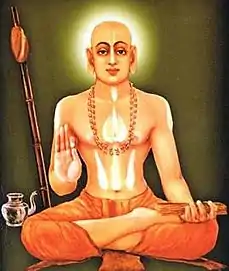Raghavendra Math (Mantralayam)
Shri Raghavendra Math, better known as Rayara Math (popularly known as Shri Raghavendra Swamy Mutt'.[1][2] Raghavendra Matha is located on the bank of Tungabhadra River in Mantralayam in Adoni taluk of Kurnool district in Andhra Pradesh, India.

| Part of a series on |
| Dvaita |
|---|
 |
| Hinduism portal |
Raghavendra Math, along with Uttaradi Math and Vyasaraja Math are considered to be the three premier apostolic institutions of Dvaita Vedanta and are jointly referred as Mathatraya .[3][4][5] It is the pontiffs and pandits of the Mathatraya that have been the principle architects of post-Madhva Dvaita Vedanta through the centuries.[6]
Raghavendra Matha to spread the tattvavada in the southern part of India. It was named Kumbakonam Matha and later it was changed as Sri Vijayendra Mutt after Vijayendra Tirtha or Vijayendra Swamigal by Sudhindra Tirtha, a disciple and successor to the pontificate of Kumbakonam Matha after Vijayindra Tirtha. After Sudhindra Tirtha his disciple, the most venerated dvaita saint Raghavendra Tirtha continued in the pontifical lineage as the pontiff of the matha. After small stay at Kumbakonam, he seems to have gone on a pilgrimage tour visiting Rameshwaram, Ramnad, Srirangam, and Mathura then he moved westwards to Udupi and Subramanya, and thence to Pandharpur, Kolhapur and Bijapur. At Kolhapur, he is said to have made long stay and at Bijapur, he made many converts.[7] After that he returned Ultimately to Kumbakonam. By 1663 he left to Mysore where he got grant from Dodda Devaraya Odeyar. Later he moved to further north and finally settled down at Mantralayam, a village on bank of river Tungabhadra in Adoni taluk in Andhra Pradesh. There on the sacred river he took Samadhi in 1671.[8]
The matha was later named after Raghavendra Tirtha as Raghavendra Matha.
Guru Parampara
- Madhvacharya
- Padmanabha Tirtha
- Narahari Tirtha
- Madhava Tirtha
- Akshobhya Tirtha
- Jayatirtha
- Vidyadhiraja Tirtha
- Kavindra Thirtha
- Vaageesha Thirtha
- Ramachandra Tirtha
- Vibudhendra Tirtha
- Jitamitra Tirtha
- Raghunandana Tirtha
- Surendra Tirtha
- Vijayeendra Tirtha
- Sudhindra Tirtha
- Raghavendra Tirtha
- Yogeendra Tirtha
- Sooreendra Tirtha
- Sumateendra Tirtha
- Upendra Tirtha
- Vadeendra Tirtha
- Vasudhendra Tirtha
- Varadendra Tirtha
- Dheerendra Tirtha
- Bhuvanendra Tirtha
- Subodhendra Tirtha
- Sujanendra Tirtha
- Sujnanendra Tirtha
- Sudharmendra Tirtha
- Sugunendra Tirtha
- Suprajnendra Tirtha
- Sukrutheendra Tirtha
- Susheelendra Tirtha
- Suvrateendra Tirtha
- Suyameendra Tirtha
- Sujayeendra Tirtha
- Sushameendra Tirtha
- Suyateendra Tirtha
- Subudhendra Tirtha – Present Pontiff[9]
References
- Venkataraya Narayan Kudva (1972). History of the Dakshinatya Saraswats. Samyukta Gowda Saraswata Sabha. p. 196.
- Purabhilekh-puratatva: Journal of the Directorate of Archives, Archaeology and Museum, Panaji-Goa, Volume 2. The Directorate. 2001. p. 90.
This matha was established by one Vibhdeendra Teertha in the middle of the 15th century. He was the spiritual progenitor of Sri Ramachandra Teertha of the Uttaradi matha. Both belong to Dvaita philosophy.
- Sharma 2000, p. 199.
- Steven Rosen (30 November 1994). Vaisnavism. Motilal Banarsidass Publishers. p. 132. ISBN 9788120812352.
- Sharma 2000, p. 193.
- B. N. Hebbar (2004). Viśiṣṭādvaita and Dvaita: A Systematic and Comparative Study of the Two Schools of Vedānta with Special Reference to Some Doctrinal Controversies. Bharatiya Granth Niketan. p. 29. ISBN 9788189211011.
- Sharma 2000, p. 483.
- Sharma 2000, p. 484.
- "Subudhendra Tirtha takes charge of Mantralayam math". The Hindu. Retrieved 12 March 2014.
Bibliography
- Sharma, B. N. Krishnamurti (2000). A History of the Dvaita School of Vedānta and Its Literature, Vol 1. 3rd Edition. Motilal Banarsidass (2008 Reprint). ISBN 978-8120815759.